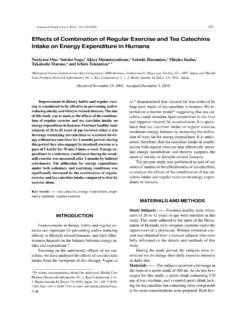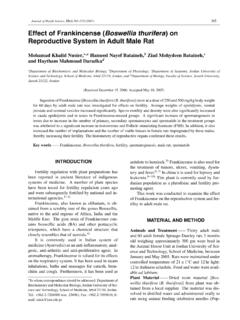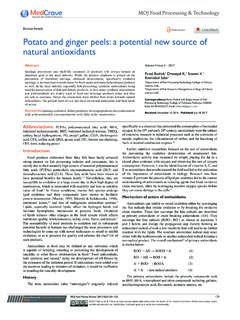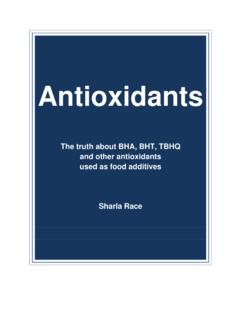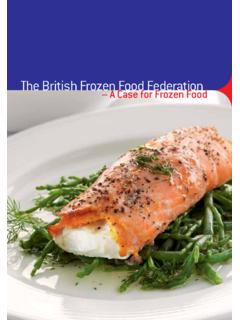Transcription of Journal of Health Science, 49(1) 45–54 (2003) - Pharm
1 45 Journal of Health Science, 49(1) 45 54 (2003)Analysis ofProanthocyanidins in GrapeSeed Extracts, Health Foodsand Grape Seed OilsYumiko Nakamura,* Sumiko Tsuji, andYasuhide TonogaiDivision of Food Chemistry, National Institute of Health Sci-ences, Osaka Branch 1 1 43, Hoenzaka, Chuo-ku, Osaka 540 0006, Japan(Received August 13, 2002; Accepted September 20, 2002)Grape seed extract (GSE) is one of Japan's natu-ral food additives, and is recommended for use as anantioxidant. The component of interest is polyphenol,mainly proanthocyanidins, which are condensedtannins. A vanillin-hydrochloric acid (HCl) assay is spe-cific for flavan-3-ol. The sensitivity of GSE componentsto the vanillin-HCl assay differed according to thechemical structure.
2 We applied this assay to the deter-mination of proanthocyanidin content in GSEs, healthfoods containing GSEs and grape seed oils. The con-centration of proanthocyanidins in GSEs and healthfoods was overestimated in the vanillin-HCl assay when(+)-catechin was used as a standard. However, the con-centration of proanthocyanidins in Health foods withhigh protein or a high colored substance content wasunderestimated. No proanthocyanidins were detectedin grape seed oil. Furthermore, we examined the con-tent of low molecular weight compounds in GSE byreversed-phase HPLC. The percentage of low molecu-lar weight compounds, including gallic acid, (+)-cat-echin, ( )-epicatechin, procyanidins B1, B2 and C wasestimated to be (w/w).
3 Key words grape seed extract, proanthocyanidins,vanillin-hydrochloric acid assay, reversed-phase HPLC, Health food, grape seed oilINTRODUCTIONG rape seed extract (GSE) is a natural food addi-tive approved in Japan. Its standard usage is as anantioxidant in confectionery or processed fisheryfoods at a concentration of In Japan, GSEis used as a Health food material rather than as afood additive (by private communication with at Japan Food Additives Association). Theconsumption of GSE in Japan is approximately100000 ) The biologically active constitu-ents of GSE are proanthocyanidins (Fig. 1), whichrepresent a variety of polymers of flavan-3-ol, suchas catechin and epicatechin2 5) and have a strong anti-oxidative effect in aqueous 8)Colorimetric procedures such as the vanillin-hydrochloric acid (HCl) assay,9 11) buthanol-HCl as-say,12) and the Folin-Ciocalteau assay13) have beengenerally used for the determination ofproanthocyanidins in foodstuffs.
4 The vanillin-HClassay is specific for a narrow range of flavanols anddihydrochalcones that have a single bond at the 2,3position and free m-oriented hydroxy groups on theB ) The principle of the vanillin-HCl assay isas follows: vanillin is protonated in an acid solu-tion, giving a weak electrophilic carbocation thatreacts with the flavonoid ring at the 6 or 8 intermediate compound is dehydrated to give ared colored )In this study, we applied the vanillin-HCl assayproposed by Sun et ) to the determination ofproanthocyanidin content in GSEs, Health foods con-taining GSE and grape seed oils consumed in Ja-pan. We also determined the content of some lowmolecular weight compounds by AND METHODSM aterials Gallic acid (GA), vanillin and fla-vone were purchased from Wako Pure Industries,Ltd.
5 (Osaka, Japan). (+)-Catechin (CT) (purity> 98%), ( )-epicatechin (EC), procyanidin B1(ProB1), procyanidin B2 (ProB2) and procyanidinC1 (ProC1) were purchased from Funakoshi (To-kyo, Japan). Standards of other flavonoids and phe-nolic compounds were purchased from Funakoshior Extrasyneth se (Geney, France). 1,2,3,6-Tetra-O-galloyl -D-glucose (TGG) and 1,2,3,4,6-penta-O-galloyl -D-glucose (PGG) were kindly given byProf. T. Yoshida (Faculty of Pharmaceutical Sci-ences, Okayama University). Ion-exchanged andredistilled water was used throughout the experi-ments. HPLC grade acetonitrile, ethyl acetate, n-hexane and methanol were used for analyses. Otherreagents were analytical grades.*To whom correspondence should be addressed: Divisionof Food Chemistry, National Institute of Health sciences ,Osaka Branch 1 1 43, Hoenzaka, Chuo-ku, Osaka 540 0006,Japan.
6 Tel.: +81-6-6941-1533; Fax: +81-6-6942-0716; 49 (2003)The HPLC column Develosil 300 ODS-HG-5( mm 250 mm) was purchased from NomuraChemical Co., Ltd. (Seto, Japan).All the reagents for the vanillin-HCl assay wereprepared immediately before use. A standard stocksolution of CT for the vanillin-HCl assay was pre-pared by dissolving 10 mg of CT in 10 ml of metha-nol. The final solution of CT (20 300 g/ml) for thevanillin-HCl assay was prepared by diluting the stocksolution with adequate amounts of methanol. Vanil-lin was dissolved in methanol to give a 1% (w/v)vanillin solution. Concentrated HCl was dissolvedin methanol to give a 9 mol/l HCl A Hitachi U-3210 spectrophotom-eter was used for the vanillin-HCl assay. A ShimadzuHPLC apparatus, Class-VP Series (Kyoto, Japan),equipped with system controller SCL-10 AVP, pumpliquid chromatography (LC)-10 ADVP, degasserDGU-14A, auto injector SIL-10 ADVP, column ovenCTO-10AC and diode array detector SPD-M10 AVP,was used to analyze the low molecular weight com-pounds in GSEs #1 4 were obtained from theJapan Food Additives Association via Dr.
7 T. Maitani(National Institute of Health sciences ). GSE #5 waspurchased from a domestic manufacturer. GSEs #1and #2, GSEs #4 and #5 are the same products butdiffer in batch number. Health foods containing GSEand the grape seed oils were purchased from retailmarkets in Osaka mg of each GSE was weighed and dissolvedin methanol, and the volume was adjusted to 50 ml(sample solution). Tablets of the Health food wereground to a powder using a mill. The powder of eachhealth food was weighed and dissolved in methanolto a final concentration of 150 250 g/ml ofproanthocyanidins (sample solution). The centrifu-gation process (3000 rpm 15 min) was performedif necessary and the supernatant was used in the van-illin-HCl assay. The lipid in 1 g of grape seed oilwas removed by a n-hexane/acetonitrile partition,which was repeated three times.
8 Acetonitrile frac-tions were jointed, evaporated to dryness and dis-solved in 2 ml of methanol (sample solution).Vanillin-HCl Assay Proanthocyanidins in thesample solutions of 5 GSEs, 4 Health foods and2 grape seed oils were determined by the vanillin-HCl assay described by Sun et ) To 1 ml of CTsolution (0 300 g/ml in methanol) or test solution(150 250 g/ml polyphenols in methanol) in a testtube, ml of methanol (control) or 1% vanillinsolution in methanol (sample) and ml of 9 mol/lHCl in methanol was added. The reaction mixturewas incubated for 20 min at 30 C and the absorbanceat 500 nm was measured. The following A0, Ab, Ac,As was measured for each standard and = Absorbance at 500 nm of the control of0 mg CT [1 ml methanol + ml methanol + ml9 mol/l HCl].
9 Ab = sample of 0 mg CT [1 ml methanol + ml1% vanillin solution + ml 9 mol/l HCl].Ac = control [1 ml CT (20 300 g/ml) or testsolution + ml methanol + ml 9 mol/l HCl].As = sample [1 ml CT (20 300 g/ml) or testsolution + ml 1% vanillin + ml 9 mol/l HCl].A was calculated as follows for each standardand sample solution:A = (As Ab) (Ac A0)A calibration curve was prepared using A for theCT solution using the above calculation. Total flavan-3-ol in each test solution was calculated from thecalibration Vanillin-HCl assay was performed 3 5 timesfor each HPLC HPLC was performedas follows: apparatus, Shimadzu Class VP series;column, Develosil 300 ODS-HG-5; column oventemperature, 35 C; mobile phase, (A) water/phos-phoric acid 1000 : 1 (v/v), (B) acetonitrile/phospho-ric acid 1000 : 1 (v/v); gradient program B, 0%(0 min) 15% (20 min) 30% (25 min) 100%(45 61 min) 0 (62 77 min); a fluorescence de-Fig.
10 Structure of Proanthocyanidins47No. 1tector, ex 283 nm, em 317 nm for CT, EC, ProB1,ProB2 and ProC2; diode array detector (DAD),monitoring wavelengths, 210 nm; injection volume,10 acid has an absorbance at 210 nm,therefore the HPLC chromatograms were correctedby subtracting the base AND DISCUSSIONV anillin-HCl AssayThe detection limit of the vanillin-HCl assaydescribed here was 5 g CT. The linear range of thecalibration curve for the vanillin-HCl assay was 10 400 g/ml (r2 = ).The reactivity of various polyphenols in the van-illin-HCl assay is shown in Table 1. Reaction in thevanillin-HCl assay (shown by the presence of a redcompound) was detected in flavan-3-ol, procyanidinTable of Various Polyphenol to Vanillin-HCl Assaya)CompoundsMolecular weightVanillin-HCl methodTrivial nameCategoryReactivityb) maxSensitivity (Catechin as )[nm]per mgper Biochanin (+) ( ) B1 Procyanidin B2 Procyanidin C1 Procyanidin ( ) ( ) ( )-Catechin ( )-Epicatechin ( )-Gallocatechin ( )-Epigallocatechin acidPhenolic Ellagic acid(Phenolic acid)

